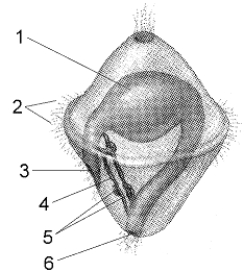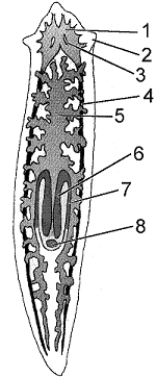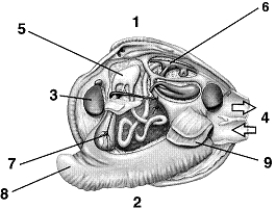Correct Answer

verified
Correct Answer
verified
Multiple Choice
Figure 31-4
Use the figure to answer the corresponding question(s) .  -The larva in Figure 31-4 is:
-The larva in Figure 31-4 is:
A) a veliger.
B) a glochidium.
C) a trochophorE.
D) a nauplius.
E) a pupa.
Correct Answer

verified
Correct Answer
verified
Multiple Choice
You have a sample of cat emesis (vomit) and find worms in the sample.The cylindrical worms are long and slender, pointed at each end, with no other distinguishing characteristics.They are members of the phylum:
A) Platyhelminthes.
B) NematodA.
C) CnidariA.
D) AnnelidA.
E) Nemertea.
Correct Answer

verified
Correct Answer
verified
Multiple Choice
Figure 31-4
Use the figure to answer the corresponding question(s) .  -The larva in Figure 31-4 is characteristic of:
-The larva in Figure 31-4 is characteristic of:
A) arthropods.
B) mollusks.
C) cnidarians.
D) platyhelminths.
E) nematodes.
Correct Answer

verified
Correct Answer
verified
Essay
MATCHING Match the organism or its characteristic with the correct phylum. a.Annelida f.Nematoda b.Arthropoda g.Nemertea c.Cnidaria H.Platyhelminthes d.Ctenophora I.Porifera e.Mollusca J.Rotifera -Hydra
Correct Answer

verified
Correct Answer
verified
True/False
A member of subphylum Chelicerata is a spider. ____________________
Correct Answer

verified
Correct Answer
verified
Multiple Choice
Figure 31-2
Use the figure to answer the corresponding question(s) .  -Refer to Figure 31-2.The structure labeled 5 is used for:
-Refer to Figure 31-2.The structure labeled 5 is used for:
A) food intakE.
B) digestion.
C) locating fooD.
D) coordination of movement.
E) locomotion.
Correct Answer

verified
Correct Answer
verified
Multiple Choice
_______ are also called velvet worms.
A) Nematodes
B) Annelids
C) Tartigrades
D) Onychophorans
E) Arthropods
Correct Answer

verified
Correct Answer
verified
Multiple Choice
Figure 31-5
Use the figure to answer the corresponding question(s) .  -Critical to polychaete and oligochaete locomotion are:
-Critical to polychaete and oligochaete locomotion are:
A) jointed appendages.
B) parapodiA.
C) setaE.
D) fins.
E) tentacles.
Correct Answer

verified
Correct Answer
verified
Essay
MATCHING Match the organism or its characteristic with the correct phylum. a.Annelida f.Nematoda b.Arthropoda g.Nemertea c.Cnidaria H.Platyhelminthes d.Ctenophora I.Porifera e.Mollusca J.Rotifera -centipedes
Correct Answer

verified
Correct Answer
verified
True/False
The polyp form of a cnidarian has its tentacles pointed downward. ____________________
Correct Answer

verified
Correct Answer
verified
Essay
MATCHING Match the organism or its characteristic with the correct phylum. a.Annelida f.Nematoda b.Arthropoda g.Nemertea c.Cnidaria H.Platyhelminthes d.Ctenophora I.Porifera e.Mollusca J.Rotifera -Scyphozoans
Correct Answer

verified
Correct Answer
verified
Essay
MATCHING Match the organism or its characteristic with the correct phylum. a.Annelida f.Nematoda b.Arthropoda g.Nemertea c.Cnidaria H.Platyhelminthes d.Ctenophora I.Porifera e.Mollusca J.Rotifera -squids
Correct Answer

verified
Correct Answer
verified
Multiple Choice
Segmentation in arthropods differs from that of annelids because arthropod segments are:
A) smaller.
B) less specializeD.
C) only present in adults.
D) more specializeD.
E) only present in larvae.
Correct Answer

verified
Correct Answer
verified
Multiple Choice
Sponge larvae:
A) are miniature sponges that float about in the plankton.
B) crawl along the bottom like an amoebA.
C) are flagellated and able to swim.
D) bud off the adult spongE.
E) float out of the adult, fall to the bottom, and attach to form a new sponge.
Correct Answer

verified
Correct Answer
verified
Multiple Choice
Figure 31-2
Use the figure to answer the corresponding question(s) .  -The anterior end of a tapeworm is known as the:
-The anterior end of a tapeworm is known as the:
A) proglottiD.
B) cnidocytE.
C) auriclE.
D) protonephridiA.
E) scolex.
Correct Answer

verified
Correct Answer
verified
True/False
In sponges, spicules are secreted by amoeboid cells. ____________________
Correct Answer

verified
Correct Answer
verified
Multiple Choice
Clams and oysters are:
A) detritivores.
B) herbivores
C) omnivores.
D) carnivores.
E) filter feeders.
Correct Answer

verified
Correct Answer
verified
True/False
The body of a tapeworm consists of segments, each of which is called a proglottid. ____________________
Correct Answer

verified
Correct Answer
verified
Essay
MATCHING Match the organism or its characteristic with the correct phylum. a.Annelida f.Nematoda b.Arthropoda g.Nemertea c.Cnidaria H.Platyhelminthes d.Ctenophora I.Porifera e.Mollusca J.Rotifera -Obelia
Correct Answer

verified
Correct Answer
verified
Showing 101 - 120 of 146
Related Exams